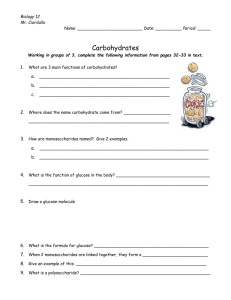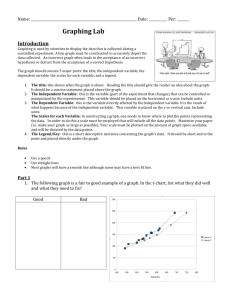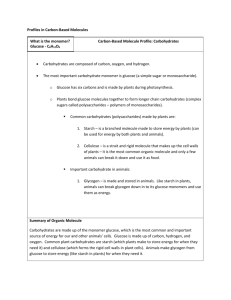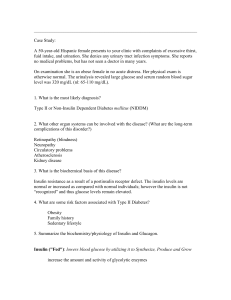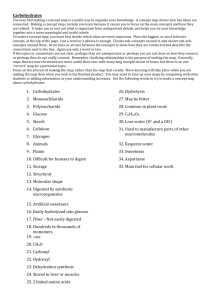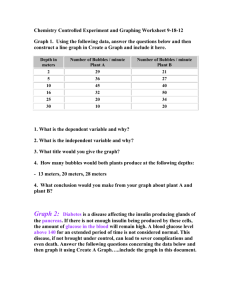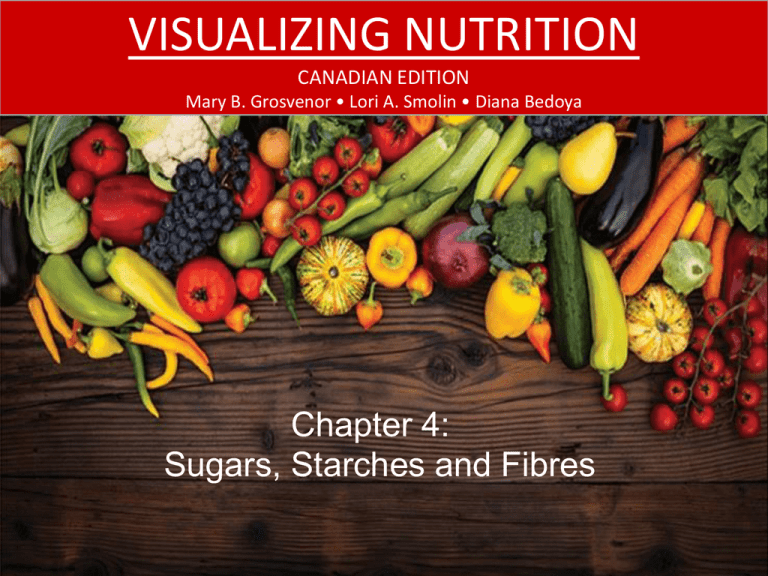
VISUALIZING NUTRITION
CANADIAN EDITION
Mary B. Grosvenor • Lori A. Smolin • Diana Bedoya
Chapter 4:
Sugars, Starches and Fibres
CHAPTER 4: SUGARS, STARCHES AND FIBRES
LEARNING OBJECTIVES
At the end of this chapter, you should be able to:
• Distinguish whole grains from refined sugars
• Compare types of carbohydrates
• Describe digestion and absorption of carbohydrates
• Understand carbohydrate function
• Describe the role of carbohydrates in health and
disease
• Plan a diet to meet carbohydrate recommendations
THINK about this – then share within
a PAIR – then SHARE with the class
• What do you know about sugars, starches, and fibre?
• What are whole grains and refined sugars?
• How are whole grains and refined sugars important for
your health?
Whole grains vs. refined grains
• Whole grains: contain the whole kernel, including the
germ, the bran, and the endosperm
• Refined grains: food processed to remove course parts
• Removed parts contain fibre, some vitamins, minerals and
phytochemicals
© Can Stock Photo Inc. / artjazz
Whole grains vs. refined grains
The endosperm is the largest part
of the kernel. It is made up of
primarily starch, but it also
contains most of the kernel’s
protein, along with some vitamins
and minerals.
The outermost bran layers contain
most of the fibre and are a good
source of many vitamins and
minerals.
The germ, located at the base of
the kernel, is the embryo where
spouting occurs. It is a source of
oil and is rich in vitamin E.
Enrichment
• Refined grains sold in Canada
are enriched
• Enrichment is a type of
fortification
• Adds back some of the nutrients
lost in processing
• Includes specific amounts of
thiamin, riboflavin, niacin, and
iron and folic acid
Empty calories
• Empty calories: foods that contain energy but few additional
nutrients
• Refined sugars contain calories but lack fibre,
phytochemicals and other nutrients
• Foods containing natural sugars (fruits, milk, etc.) - higher
nutrient density than foods with added refined sugars
Concept check
• What is the difference between a whole-grain product
and a product made with a refined grain?
• Why are foods high in added refined sugars said to
contribute empty calories?
Concept check
In a refined grain, which part remains?
a)
b)
c)
d)
Germ
Bran
Endosperm
All of the above
Types of carbohydrates
• Carbohydrates are made up of one or more sugar units
that contain carbon, hydrogen, and oxygen
• Monosaccharides are made up of a single sugar unit
• Disaccharides are made up of two sugar units
• Polysaccharides are made up of two or more sugar
units linked together
Simple carbohydrates
• Monosaccharides and disaccharides are classified as
simple carbohydrates
• The most common monosaccharides in our diet are
glucose, fructose and galactose
• The most common disaccharides in our diet are
maltose, sucrose and galactose
Disaccharides vs. Monosaccharides
Disaccharides vs. Monosaccharides
Disaccharides vs. Monosaccharides
1. Obtain one sticky note
2. Pair up with another student to form a disaccharide
Which disaccharide did you make?
Galactose
Glucose
Lactose
Complex carbohydrates
Complex carbohydrates are polysaccharides that
include:
• Glycogen, made up of glucose; branched; stored in
animal liver and muscles; not present in our diet
• Starch, made up of glucose; branched or straight
chains; found in plants
• Fibre, made up of glucose with bonds that cannot be
digested and absorbed by humans
Complex carbohydrates
©iStockphoto.com/RedHelga
The polysaccharide glycogen is made
of highly branched chains of glucose.
This branched structure allows
glycogen, which is found in muscle
and liver, to be broken down quickly
when the body needs glucose.
Different types of starch consist of
either straight chains or branched
chains of glucose. We consume a
mixture of starches in grain
products, legumes, and other
starchy vegetables.
Most fibre is made of either straight or
branched chains of monosaccharides,
but the bonds that link the sugar units
cannot be broken by human digestive
enzymes. For example, cellulose,
shown here, is a fibre made up of
straight chains of glucose molecules. It
is found in wheat bran and broccoli.
Photosynthesis
Glucose is produced in plants
through the process of
photosynthesis, which uses energy
from the sun to convert carbon
dioxide and water to glucose.
Plants most often convert
glucose to starch. When a
human eats plants, digestion
converts the starch back to
glucose.
Excess glucose is stored as
glycogen in skeletal muscle
and liver, the rest – as fat
Soluble fibre vs. insoluble fibre
Soluble fibre:
• Dissolves in water
• Partially digested by bacteria in large intestine
• Helps lower cholesterol, prevents type 2 diabetes
• Examples: pectins, gums, & some hemicelluloses
Insoluble fibre:
• Does not dissolve in water
• Not digested by bacteria in large intestine
• Promotes regular bowel movements, binds toxins, etc.
• Examples: cellulose, some hemicelluloses, & lignin
Soluble fibre vs. insoluble fibre
• Jams and jellies are
thickened with pectin, which
is a soluble fibre found in
fruits and vegetables.
• Some foods are thickened
with gums, which combine
with water to keep solutions
from separating. They include
arabic, karaya, guar, locust bean, xanthan, and tragacanth
gums, which are extracted from shrubs, trees, and seedpods.
Other gums are derived from seaweed, including agar,
carrageenan, and alginates.
© Can Stock Photo Inc. / brozova
© Can Stock Photo Inc. / Elenathewise
Soluble fibre vs. insoluble fibre
Beans contain soluble fibre and
small polysaccharides that
cannot be broken down by
human digestive enzymes. Both
of these pass into the large
intestine, where their digestion
by bacteria creates gas. Overthe-counter enzyme tablets and
solutions (such as Beano®) can
be taken to digest the small
polysaccharides and thus reduce
the amount of gas produced.
Starch
1. Galactose or lactose students return to seats
2. If you were glucose, come to the front of the room and
form a polysaccharide
Which polysaccharide did you make?
Glucose
Glucose
Glucose
Glucose
Starch digestion
1. Break apart into pairs to form disaccharides
Which disaccharide did you make?
Glucose
Glucose
Glucose
Glucose
Glucose
Glucose
Glucose
Glucose
What are similarities and differences
between:
• Glucose and maltose?
• Maltose and starch?
• Starch and fibre?
• Starch and glycogen?
• Glucose and glycogen?
Concept check
Amylase breaks down starch into which disaccharide?
a)
Glycogen
b)
Maltose
c)
Glucose
d)
Sucrose
Carbohydrate digestion
Lactose intolerance
•
•
•
•
•
Low levels of small intestine enzyme lactase
The disaccharide lactose cannot be broken down
into monosaccharides
Lactose passes into the large intestine where it is
digested by bacteria
Symptoms: gas, abdominal distension, cramping,
diarrhea
Obtain calcium from: tofu, legumes, dark green
vegetables, canned salmon and sardines, calciumfortified foods, calcium supplements, lactase-treated
milk
Indigestible carbohydrates
•
•
Fibre: not broken down by human enzymes
Oligosaccharides: 3–10 sugar units; some are not
broken down by human enzymes
Resistant starch: the structure of the grain prevents
breakdown of the starch it contains
•
•
•
Resistant structure can occur naturally or be the result of
cooking and processing
Examples: legumes, unripe bananas, and cold cooked
potatoes, rice, and pasta
Indigestible carbohydrates
Stool weights are greater and transit times
shorter for Ugandan villagers, who consume
a diet high in fibre, than for British subjects,
who consume a more refined, low-fibre diet.
(Source: Adapted from Burkitt, D.P., Walker, A.R.P., and Painter,
N.S. Dietary fibre and disease. JAMA 229:1068–1074, 1974.)
Indigestible carbohydrates
Indigestible carbohydrates:
converted by colon to fatty acids.
The acidic conditions inhibit the
growth of undesirable bacteria
and favour the growth of healthy
bacteria, such as the
Bifidobacteria shown here.
Fatty acids may also protect
against colon cancer and may
prevent and treat inflammation
in the bowel, which causes
diarrhea.
Glycemic index vs. load vs. response
• Glycemic response: measure of how quickly, how high
and for how long blood glucose levels rise after
carbohydrate consumption
• Glycemic index: ranking of how a food affects blood
glucose relative to an equivalent amount of
carbohydrate from a reference food, such as white
bread or pure glucose
• Examples: white bread = 100, kidney beans = 25
• Glycemic load: compares the effect of typical portions
(servings) of food on blood glucose
© Can Stock Photo Inc. / Pichunter
Glycemic index (GI)
Carbohydrate functions
• Provide energy!
• Other functions:
• Monosaccharides:
• Galactose: used by nerve cells and to make milk in
breastfeeding women
• Ribose & deoxyribose: components of DNA & RNA
• Ribose: also a component of B vitamin riboflavin
• Oligosaccharides:
• Cell membrane signaling
• Polysaccharides
• Cushioning and lubrication
Insulin vs. glucagon
• During and after a meal: rising blood glucose levels
promote release of the pancreatic hormone insulin
• Insulin stimulates:
• glucose uptake by the cells
• glucose use for energy
• conversion of glucose to glycogen and fat
Insulin vs. glucagon
• Several hours after a meal: glucacon, another
pancreatic hormone, glucagon is released
• Glucagon stimulates:
• breakdown of liver glycogen
• release of glucose to blood
• gluconeogenesis
Insulin vs. glucagon
Increased
blood
glucose
Decreased
blood
glucose
Insulin
secretion
Glucose
taken
into cells
Decreased
blood
glucose
Glucagon
secretion
Glucose
released
from liver
Increased
blood
glucose
Insulin vs. glucagon
Glucose as a source of energy
Cellular respiration of glucose
• Glycolysis: splitting glucose into two three-carbon
pyruvate molecules; no oxygen required
• Anaerobic metabolism: metabolism in the absence of
oxygen
• Produces 2 molecules of ATP per glucose molecule
• Lactic acid is a by-product
• Aerobic metabolism: metabolism in the presence of
oxygen
• Produces 30 molecules of ATP
• Carbon dioxide and water are by-products
Protein and fat breakdown
• Glucose is the primary source of energy for the brain
and red blood cells
• If blood glucose is low or absent:
• Glucose can be synthesized via gluconeogenesis from
amino acids released during protein breakdown
• Ketone bodies are produced from fatty acids
Ketones
• Ketones or ketone bodies: acidic molecules produced
by fat breakdown when carbohydrates are not
available to cells
• Heart, muscle and kidneys use for energy
• Brain adapts after 3 days to use ketones
• Produced with starvation, low-carb diets, diabetes
• Ketosis: increased ketones in blood
• Ketoacidosis: acidic blood from increased ketones
Ketone formation
Fatty acids are broken down into two-carbon
units that form acetyl CoA. To proceed
through aerobic metabolism, acetyl CoA
must combine with oxaloacetate, a molecule
derived primarily from carbohydrate. When
carbohydrate is in short supply, molecules of
acetyl CoA react with each other to form
ketones. The presence of carbohydrate
allows fatty acids to be completely broken
down to yield ATP.
Concept check
Which hormone is secreted when blood glucose is
low?
a)
b)
c)
d)
Insulin
Glycogen
Ketones
Glucagon
• What do you know about diabetes mellitus?
Diabetes mellitus
• Disease characterized by high blood glucose
• Type 1: elevated blood glucose; absolute insulin
deficiency
• Autoimmune destruction of insulin-secreting cells in the
pancreas
• Type 2: insulin resistance; relative insulin deficiency
• Gestational: first observed during pregnancy;
increased risk of type 2 diabetes later in life
Diabetes mellitus
• Normal blood
glucose is >6
mmol/L bloodafter
an eight-hour fast;
a fasting blood
level of 6.1–6.9
mmol/L is defined
as prediabetes; a
fasting level ≥7
mmol/L is defined
as diabetes.
• Two hours after consuming 75 g of glucose, normal blood
levels are <7.8 mmol/L; prediabetes levels are 7.8-11 mmol/L;
and diabetes levels are ≥ 11.1 mmol/L
Incidence of diabetes mellitus in
Canada
The incidence of diabetes in Canada is rising. Newfoundland and Labrador,
Nova Scotia, Manitoba, Ontario, and New Brunswick have the highest rates of
diabetes, while Alberta, British Columbia, and Quebec have the lowest rates. In
most provinces, rates in men are higher than in women, but rates are higher in
women in Yukon and the Northwest Territories.
Diabetes mellitus signs & symptoms
• High blood glucose because insulin does not signal
cells to take up glucose
• Causes weight loss resulting from break down of fat and
protein and loss of water
• Causes increased hunger because cells are starved for
glucose
• Increased glucose in urine
• Water tries to dilute glucose leading to increased excretion of
water causing dehydration and thirst
Diabetes mellitus complications
Diabetes mellitus management
• Control blood sugar levels
• Limit carbohydrate intake
• Increase whole grains and vegetables, decrease refined sugars;
limit saturated fats, trans fats, and cholesterol
• Insulin injections for type 1 & some type 2 patients; type 2
patients often take oral drugs
• Manage weight
• Exercise
• Exercise and weight loss in type 2 helps prevent, reverse, and
manage the disease
What are similarities and differences
between:
• Insulin and glucagon?
• Type 1 and type 2 diabetes mellitus?
Hypoglycemia
• Abnormally low blood glucose levels
• Caused by:
• Overmedication with insulin
• Abnormal secretion of or response to insulin or other
hormones
• Fasting hypoglycemia: when a person has not eaten
and usually has some other condition
• Reactive hypoglycemia: insulin response to a highcarbohydrate meal
Dental caries (cavities)
• Bacteria in mouth digest carbohydrates and produce
acid which damages tooth enamel
• Increased risk:
• Increased intake of sucrose and starch
• Frequent and prolonged exposure
Carbohydrates & calorie intake
©iStockphoto.com/EasyBuy4u
© Can Stock Photo Inc. / SasPartout
• The fat added to high-carbohydrate foods
increases calorie count. A medium baked
potato = about 160 kcal. Adding 30 mL (2
tablespoons) of sour cream brings the total
to > 200 kcal; adding 30 mL (2 tablespoons)
of butter more than doubles the total kcal.
• A diet high in sugar-sweetened beverages
may increase caloric intake because they
do not induce satiety to the same extent as
solid carbohydrates.
• A diet high in unrefined, fiber-rich wholegrain carbohydrates may help reduce food
intake by adding bulk (feeling of fullness)
and slowing digestion.
Weight management
• Low carbohydrate diets
• Diets height in fibre
• Replacement of refined sugar with non-nutritive
sweeteners; pros and cons:
+
+
−
−
−
Decrease dental caries
Control blood sugar
Associated with weight gain
Present in low nutrient density foods
Toxic at high doses
Non-nutritive sweeteners
Sucralose, the sweetener in
Splenda, is 600 times sweeter
than sucrose. The ADI is 5
mg/kg of body weight/day, and
one packet contains about 12
mg of sucralose. A 70-kg (154lb.) person could consume 29
packets without exceeding the
ADI.
Aspartame, the sweetener in
NutraSweet and Equal, is 200
times sweeter than sucrose.
The ADI is 50 mg/kg of body
weight/day, and one packet
contains 37 mg of aspartame.
To exceed the ADI, a 70-kg
(154-lb.) person would have
to consume 95 packets or 16
355-mL (12-oz.) aspartamesweetened beverages.
In the United States, Sweet’n Low is primarily
composed of saccharine, which is 300 times sweeter
than sucrose. In Canada, since saccharin is still not
approved for use, Sweet’n Low’s main ingredient is
cyclamate, which is 30-50 times sweeter than sugar.
Its ADI is approximately 5 mg/kg of body weight/day.
It is not recommended for pregnant women.
Andy Washnik
Carbohydrate and heart disease
• High sugar diets:
• increase blood glucose levels; damage blood vessels
• increase lipid levels, which accumulate in arteries
• High fibre diets:
• Soluble fibre: decrease cholesterol absorption; may decrease
cholesterol synthesis in the liver
• Insoluble fibre: may decrease blood pressure, body weight,
blood glucose, obesity and other heart disease risks
Soluble fibre & cholesterol
Bowel health
• High-fibre diets decrease:
• Constipation (if adequate water is consumed)
• Hemorrhoids (varicose veins in the anus and rectum)
• Diverticula (outpouching of the large intestines)
• May reduce risk of colon cancer
Diverticulosis
Diverticula (the singular is diverticulum): outpouches in the
wall of the colon that form at weak points due to pressure
exerted when the colon contracts.
Diverticulitis: inflammation caused by fecal matter
accumulation in these pouches
High-fibre diet is recommended to prevent diverticulitis.
Carbohydrate recommendations
• Enough carbohydrate to meet glucose needs
• Choosing the right types for health & disease
prevention
• RDA for carbohydrate = 130 g/day
• Acceptable Macronutrient Distribution Range for
carbohydrate = 45–65% of total calorie intake
• AI for fibre = 38 g/day for men & 25 g for women/day
How much carbohydrate do you eat?
Next divide the number of kilocalories from
carbohydrate by the total number of kilocalories
in the diet and multiply by 100 to convert it to a
percentage. In this example, the diet contains
2,000 total kilocalories, and so it provides:
(1,200 kilocalories from carbohydrate/2,000
kilocalories total) × 100 = 60% of kilocalories
from carbohydrate. This value is between the
AMDR of 45–65% daily energy from
carbohydrates.
© Anna Oksimowicz / Alamy
Determine the number of grams of carbohydrate
and multiply this value by 4 kilocalories per
gram. For example, this vegetarian diet provides
about 300 grams of carbohydrate:
300 g × 4 kcalories/g = 1,200 kilocalories from
carbohydrate
Calculate
• Total calories = 3,000
• Total carbohydrates = 500 grams
• Carbohydrates = 4 calories/gram
• Fibre = 20 grams
Put it together
What is the percentage of calories from
carbohydrate in a diet that provides 240 grams of
carbohydrate and 2400 Calories?
a)
b)
c)
d)
10
40
50
60
Thinking it through
Choose a combination of fruits and
vegetables from this list that will add
at least 13 grams of fibre to the diet.
Choosing carbohydrate wisely
• Eating Well with Canada’s Food Guide recommends:
• increasing consumption of whole grains, vegetables, and fruits
• limiting bakery products, candy, soft drinks, and other foods
high in added sugars
• For a 2,000-kilocalorie diet, the food guide
recommends that:
• adult females consume six to seven servings of grain products
• adult males consume eight servings of grain products a day
• at least half of the grain servings should be whole grains
Healthy Canada’s Food Guide
carbohydrate choices
Interpreting food labels
Interpreting food labels
Luisa Begani
• Food labeled “source of
fibre,” “high source of
fibre,” and “very high
source of fibre” must
respectively contain at
least 2, 4, and 6 grams of
fibre per serving
Interpreting food labels
Nutrition in the news
• Low-carb diets
• High-fructose corn syrup
• Vending machines in schools
• Artificial sweeteners
• Taxes on sugar-sweetened beverages
Checking student learning outcomes
• How are whole grains and refined sugars similar and
different? How do they contribute to health and
disease?
• How are types of carbohydrates similar and different?
• What advice would you give to a loved one about
carbohydrate consumption?
COPYRIGHT
Copyright © 2014 John Wiley & Sons Canada, Ltd.
All rights reserved. Reproduction or translation of
this work beyond that permitted by Access Copyright
(The Canadian Copyright Licensing Agency) is
unlawful. Requests for further information should be
addressed to the Permissions Department, John
Wiley & Sons Canada, Ltd. The purchaser may make
back-up copies for his or her own use only and not
for distribution or resale. The author and the
publisher assume no responsibility for errors,
omissions, or damages caused by the use of these
programs or from the use of the information
contained herein.

